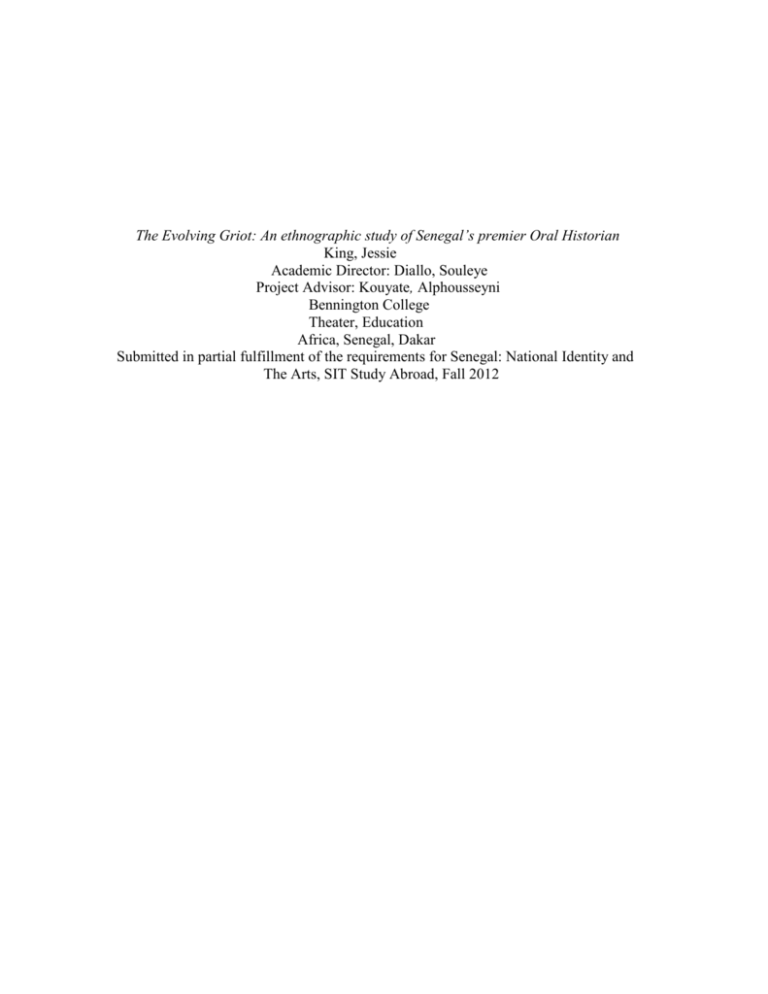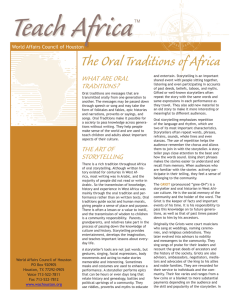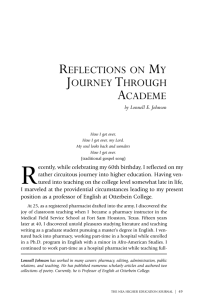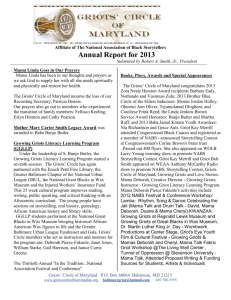Senegalese Oral Historians
advertisement

The Evolving Griot: An ethnographic study of Senegal’s premier Oral Historian King, Jessie Academic Director: Diallo, Souleye Project Advisor: Kouyate, Alphousseyni Bennington College Theater, Education Africa, Senegal, Dakar Submitted in partial fulfillment of the requirements for Senegal: National Identity and The Arts, SIT Study Abroad, Fall 2012 1 Acknowledgments: I want to thank my advisor Alphousseyni Kouyate for his guidance on this project and for introducing me to his fellow griot friends. Also, I want to give special thanks to djembe master Mamadou Fall and the dancers at Daniel Sorano for allowing me to observe their rehearsals. Thank you to everyone at SIT for supporting my work and to thanks to my host-family for their patience with my developing French. ISP Topic Codes: 2 Table of Contents Abstract: Pg. 3 Introduction: Pg. 4-6 Methodologies: Pg. 6-11 Results and Analysis: Pg. 11-23 Conclusion: Pg. 23-24 Bibliography: Pg. 25 Appendix: Pg. 26 3 Abstract: At Bennington College I explore the interdisciplinary relationship between teaching and the theatrical arts. I believe that worldwide; theater and the arts are a means of both entertainment and of education. Furthermore, teaching is inherently performative and draws on many elements of oral storytelling. I would like to look at how griots bridge the link between performer and teacher for their Senegalese audiences. For centuries, griots have held the esteemed role in Senegalese society of actor, educator, mediator and keepers of tradition. Through their craft, griots imparts morals and conduct codes of living on their audiences. I want to find out how their stories continue to inform listeners and shape Senegalese norms of society. With the disappearance of Kings and outdated African caste systems, what role do griots play in modern Senegal? Accordingly, how do griots fare today in a country that no longer relies on live entertainment for amusement? As westernization poses threats to the sanctity of the griot’s profession, new mediums will foster their economic and social survival. Modern day griots must augment their practice to serve two goals: engage contemporary spectators and make enough capitol to support themselves. My overarching question is what role do Senegalese griots serve for 21st century audiences? 4 Introduction: “Personnages pittouresque et complexes, a la fois admires et redoutés, les griots constituent un groupe professionnel endogame situé comme les artisans, auxquels ils sont rattachés, au bas de l’eéchelle.” (Leymarie 1999) For the purposes of this paper, I will refer to this member of society, as a “griot.” The reader should know that this Anglophone term is only one of the many used to label this historical figure. Many theories exist for the origin of the name “griot.” It is undeniable that both African and European influences have collaborated in the construction of this term. As explained by Thomas A. Hale in his work in Griots and Griottes, “The most common theory is that Griot comes form the French guiriot, ancestor of griot, which first appeared in 1637. Other views hold that griot comes form the Wolof term gawlo, Fulbe gawlo, Mande jelo, jail, Portuguese criado, grito, gritalhao, or the Portuguese term for Jew, judeu, Spanish guirigay, Catalan guirigaray, Berber and Jassaniya Arabic iggio, egeum, and Arabic quewal via guewal.” (Hale 1998) As this work will include interviews and testimonies from griots and non-griots of various ethnicities, I feel that the use of the English/French term griot is the most encompassing for my work across ethnic divides. Also, as I wish to make the work of the griot most accessible for Western audiences, I find this term to be the most suitable. It is difficult to categorize the work of the griot because their craft varies so immensely throughout time and between ethnic groups. However, in their height of their celebrity, griots were known as the musicians, singers, entertainers and geologists of the king’s court. The various terms mentioned above have an underlying theme in their description of this figure. The various languages define griots as “wordsmiths and 5 masters of words.” Through their epics, griots preserve the memory of kingdoms past and lay the groundwork for happenings of the future. In dates proceeding the 19th century, they served as the mouthpiece for African leaders, as kings were not allowed to speak in public. Similarly, as is forbidden to sing one’s own praises in African society, griots served to sing their praises for them, highlighting the accomplishments of their patrons. From this lens, one can observe the power the griot held in their accounts of history. As African literature remains predominately oral, their narratives serve as an essential piece in the construct of Senegalese memory. Griots have the power to shape times gone by and serve as living relics of antiquity. Griots sat in a specific caste referred to as the géwél in Wolof that allowed them to perform certain activities considered potentially dangerous or unfit for other members of society. Such ceremonies include commemorations like circumcision, excision, funeral preparations and midwifery. While some civilians might deem these activities daunting, it remains true that such ceremonies are considered illegitimate if they are performed without the presence of a griot. This further illustrates the continued necessity of the griot in modern day Senegal. Besides these controversial activities, griots also play an indisputable role performing at quotidian naming ceremonies, weddings and baptisms. In the ancient epics and songs griots perform there are several key themes and morals that are repeated and infused in the lyrics and musicality of these works. These morals encourage a particular conduct code and teach audiences about Senegalese values. Some frequented griot lessons illustrate the dangerous of the jealous wife, the trials of war and death, revenge, evil enemies and means of spirituality. Griots impose a standard 6 of ethical living for their listeners. As they are often the only members of society whose knowledge dates as far back as ten generations, they are deeply respected and valued. The narratives they construct continue to impart modern Senegalese with scruples and consciences they are obligated to adopt and uphold. This reporting of morality is a venerable pedagogy and method of teaching in Senegalese society. While Griots are still employed privately by families in Senegal who require their services for such habitual formalities, the modern day griot struggles economically without the existence of pre-colonial géers. The ancient griot lived with the king and was supported financial by his patronage. Today, many griots must have secondary jobs to make a reasonable profit. Cornelia Panzacchi illustrates this challenge in her journal The livelihoods of Tradition Griots in Modern Senegal, “The political and social changes brought about by islamisation, colonial conquest and later on the westernization and modernization were likely to make the “Master of the Word” superfluous as the keeper of tradition, and the princely gifts he expected from his patron, impossible” (Panzacchi 1994) My advisor Alphousseyni Kouyate explained to me that he created his band “Dialia” to better market himself for wedding and baptism ceremonies in and around Dakar. He admitted to me, “I am going to have to adopt my griotism to the evolution of the times.” (Kouyate 2012) This sentiment will be further explored in this work in the efforts to understand how the contemporary griot endures in a less accommodating and non-dynastic society. Methodologies: Objectives 7 As someone who has devoted my secondary schooling to education and arts studies, I became interested in griots as figures that overlap the role of teacher and of the performer. I observe the griot/audience relationship as a parallel of the teacher/student relationship. I see teaching as an inherent effort to prepare students for the culture they will someday join and contribute to. Likewise, it is the griot’s duty to teach and remind their audience of shared societal values and inspire new thinking. Student and audience member are inextricably combined under the teachings of the griot. In ceremonies like weddings and baptisms, “students” actively engage in the lessons a griot lends through participation in the song, dance and festivity of the performance. I am interested in storytelling and learning through the arts as a means of teaching because I consider it innovative stray away from traditional “chalkboard style of teaching” customarily observed in French and Western pedagogies. The Senegalese griot serves as a paradigm for arts infused teaching practices I respect and admire. As Senegal continues to be subjected to Western and Islamic influences, I am curious what morals and ancient themes the griot broadcasts will remain relevant to modern audiences. The griot acts as a mechanism for the appropriation of knowledge. When the griot imparts moral teachings, audiences appropriate the lessons into their own value system. I believe learning oral histories through song and music has the potential to be translated into the classroom. In my future work, I would like use the pedagogy of storytelling the griot employs as a classroom educator. I want to share this method of Senegalese arts education with the Western world to facilitate a different kind of theatrical and enlightened classroom. 8 The second stand of my research I have devoted to the changing role of the griot in the Senegalese urban context of Dakar. My overarching question for this strand is what role does the griot serve for 21st century audiences? How have griots augmented their practice to better serve their spectators while making enough capitol to support themselves? I have discovered the potentials of modern medias such as a recording studios and radio stations as means of commercializing the griot. As noted above by my advisor, I also have found that groups of griots I observed as “bands” or “orchestras” spanning several ethnic groups can pose as successful innovations. A band of griots can better combat the competition felt by a singular griot. In my second strand of research I seek to highlight the adaptations the modern griot has made to facilitate his or her social and economic endurance. I am interested in how the young griot culminates oral histories and expertise in musicology through familial teaching. As I learned through my research, griots in most instances have no formal or academic training to account for their preparation. For nongriots, access to arts education was limited until the introduction of conservatories and arts specific schools in the 21st century. The creation of arts schools inspired a change in dynamic between griots and those of non-griot linage who aspired to be professional musicians. Access to arts education has increased tensions between griots and non-griot musicians in intense competition over ownership of the occupation and limited economic resources. In both of my strands, my guiding questions seek to reveal the complexities and difficulties that surround this Senegalese character. 9 Location I chose to conduct my research in Dakar with the exception of one informal interview I did in the village of Ethcwar during my village stay in Kedougou. This interview was conducted before the Independent Study Period to provide contrast to my anticipated “urban setting” interviews in Dakar. The village setting provides a vastly different template for studying the challenges and advantages for the modern day griot that should be reserved for another study. Dakar provides educational institutions, modern media amenities and unique social dynamics that construct a myriad of concerns for the urbanite griot. Conducting my research in Dakar also allowed for greater access to a variety of contacts and literary resources I would have not been able to locate in a more provincial setting. Research Methods: David Silverman’s, A very short, fairly interesting and reasonably cheap book about Qualitative Research, served as my literary guide for my research tactics for this project. I refer to Silverman’s definition of ethnography as “highly descriptive writing about particular groups of people” (Silverman 2007) to explain this project on griots. Through interviews, observation and participant observation I sought to look attentively at this particular caste. While griots and musicians are very commonplace in Senegalese society, I have tried to surface what Silverman calls “seeing the remarkable in the mundane.” (Silverman 2007) The histories griots sing and music they play is very commonplace in the Senegalese context. In order to expose the work of the griot, I 10 followed Silverman suggestion, “setting aside these habits is the key to the ethnographic imagination.” (Silverman 2007) My methodologies have followed this line of attentiveness in the attempt to achieve an inspired qualitative inquiry on this topic. After gaining sufficient background knowledge about the origin of griots and their history, I began conducting formal and informal interviews. I interviewed six subjects in locations in and around the Dakar area. I interviewed three female griottes and two male griots. The sixth subject was a professor of Wolof and African Studies at the University of North Carolina who provided me some insight as an expert on Youssou N’Dour. The seventh subject, whom I referred to previously, I interviewed informally during my stay at his home in Ethcwar, Kedougou. The two non-griot interviewees were helpful in constructing my findings on outsider perspectives on griots. My interview subjects were of various different ethnic groups, including but not exclusive to, Wolof, Mandingo, Bedick and Serer. My study could have allowed for a tighter analysis if it had been reserved exclusively for one ethnic group. However, time limitations did not allow for this specificity. All interviews were recorded by the use of a mobile recorder and were then transcribed for later use. Consent was either recorded orally or in more formal interviews, was accounted for by a written contract that can be found in the appendix of the paper. I was the sole conductor of the seven interviews. Alphousseyni Kouyate, Mandigo griot and English masters graduate of Universite Cheikh Anta Diop De Dakar, served as my advisor, main informant and translator for this project. He translated the interviews of Mandingo griots Fatou Diawara and Tidiane Diébaté, neither of whom spoke French or Wolof. Translations were made and recorded 11 from Mandingo to English after I posed the question to the interviewee and again after their subsequent answer. Alphousseyni Kouyate’s master thesis for UCAD, The Function and Status of the “Jali” in the Senegambian area from the 13th to 19th Century also served as a fundament to my research. In addition to my interviews, I attended and partook in various ceremonies where the quotidian work of the griot can be observed. These included three marriages, a baptism, a sabar and a return from Mecca celebration. These opportunities allowed me to observe griots and their effects on the audience. I was able to take note of the different musical styles at work and the griots function in various types of ceremonies. In addition, I often sang along and danced at these social functions to fully immerse myself in the ritual. Participant observation was vital in my understanding of the quotidian work of the griot. Results and Analysis Quotidian duties and role of the modern Day griot in Senegal In Panzacchi’s examination of the contemporary griot, she discerns there are three categories of people who descend from griot linage. “Those who have decided to refrain from practicing their hereditary profession and have taken up some other occupation, those who continue to perform, without innovation, the tasks and responsibilities handed down to them from their parents and grandparents in the traditional way, and those who have managed to find or create a new kind of occupation that seems to fit the traditional griots’ ethos, adapting the art of their ancestors to modern requirements and possibilities.” (Panzacchi 1994) I am primarily concerned with the third category of these creative griots that have found a way to bridge the link between their historic livelihoods and that of the new era. 12 Indisputably, despite the effects of modernization, griots continue to serve many quotidian functions in Dakar. I observed the remarkable lasting quality of the Senegalese griot as attributed to societal up-holdings about how to treat and favor this important figure. I would first like to discuss these up-holdings that have transcended time and displacement of the old caste system. In my first meeting with my advisor Kouyate, he explained to me that commonplace Senegalese ceremonies like weddings and baptisms are not authentic without the presence of a griot. In a discussion with my homestay family they noted that they while they knew people who employed DJ’s at such functions, it is not a proper ceremony if a griot is not in attendance. In a return from Mecca celebration I attended, I observed a Wolof griot praising their patron’s pilgrimage. I was told afterwards that the pilgrimage is considered incomplete without the recognition and praising singing of a griot at the end of the voyage. Thomas A Hale illustrates this sustained appreciation of griot livelihoods. “Griots often participate in ceremonies that mark major life events… The particular role varies from society to society and from one kind of griot to another. In some cases the griot is the master of ceremonies, in others merely one of the participants. In nearly every situation, however, it is hard to imagine the event going on without some involvement by these artisans of the word, because they bring people together with their words.” (Hale 1998) Similarily, griots are employed based on unwavering relationships between patron and griot family names. I spoke with a jalimusso1, Fatou Diawara in Pikine who confirmed this practice. Mrs. Diawara comes from a griot caste known as carankey2 in Mandingo, translated to mean “knowledge seekers.” She told me that while carankey 1 2 Mandingo term for female griotte Mandingo term for the griot caste 13 men are historically shoe and leather makers, jalimusso’s cook, clean and speak praises during typical griot rites. They are unconventional griottes in that they are not performers and do not sing or play any instruments. When I asked her how she was able to find worked she explained, Mandingo family names like Manne, Sane and Faty3 are obliged to employ her due to century old contracts. She went on to say that in exchange for the preparation of traditional dishes like ceeb u jen4 and ceeb u yapp5 she is given clothes and other gifts of compensation. (Diawara 2012) Mrs. Diawara confirmed that despite modern threats to griots like herself, familial ties would continue to protect her purpose. I believe griots continue to hold a renowned place in Senegalese society do to their respected role as educators. “In the past, each prince had his own griot who taught him about life and where his family fit into society.” (Hale 1998) While western-style schools have assumed the role of academic Senegalese education, griots still employ an equally important alternative for teaching cultural conceptions. The griots I spoke to frequently expressed their frustration that little to none Senegalese history or arts curricula are taught before University level. My advisor Kouyate, an experienced English professor at a high school, discussed the irony that his students are taught French literature and history; irrelevant to the Senegalese history and culture his students are actually involved with. As a result of French colonialism and western influence, young Senegalese citizens are left with a gap in their education regarding their own antiquities. I believe griots are left with the responsibility to increase national solidarity on this level. 3 Mandingo family last names Traditional Senegalese dish, from Wolof to English: Rice with Fish 5 Traditional Senegalese dish, from Wolof to English: Rice with Meat 4 14 They do this by teaching their Senegalese audiences about their personal ancestry and appropriating age-old morals to present day scenarios. “In spite of westernization, traditional music is still a living feature of everyday life, in Dakar as well as in the countryside. Modern Senegalese music is, however, trying to take over, claiming to be the heir of music’s ancestral function not only as entertainment but also as education. Often the song will contain a message: a political critique.” (Panzacchi 1994) In an interview with Mandingo griot Tidiane Diébaté, he spoke about the messages he conveys when he is playing and singing with his Kora6. He believes that much of the conflict he observes between Senegalese peoples is due to a lack of compassion and sense of closeness. He elaborated that he likes to mediate and inform his audiences about these issues by singing about the Mandingo maxims, badenyaa and fadenyaa. “Badenyaa in Mandingo culture means to be brothers and sisters, a sense of unity…not to be Fadenyaa, which means enemies…this is a regular problem in contemporary society… As a griot you can use this moral value to speak about that in a composition.” (Diébaté 2012) Diébaté takes advantage of his command as a griot to engage his listeners in a lesson of solidarity. I have previously stated that griots often comment on jealous wives and the dangers posed by enemies. One particular Mandingo epic explores these sentiments in a dramatic retelling of the king’s murder. A transformation occurred as Kouyate sang the epic for me. Through Kouyate’s wordsmith and artistry, I became a pupil to his jali7 teachings. This narrative was translated from Mandingo to English by Kouyate, which I later paraphrased and detailed. 6 7 Traditional griot string instrument Mandingo term for male griot 15 A King has three wives and in Mandingo society, often the third wife is the one you love the most. On day in the Malian empire, the enemies of the King approached the third wife with a plan to kill her husband. In exchange for the secrets of the King, they promised to reward the wife with many riches. Finally, she accepted. When the King returned to his wife she asked him to remove his protective amulet he wore around his waist when he went to shower. She claimed the water is not good for them and he should take them off when he bathes. At first the King refused because he knew this could make him vulnerable in the face of evil enemies. The wife pleaded with him everyday and finally he told her that when it is his turn with her tomorrow night he would remove his protection before he entered the bath. The wife consulted the enemies and told them her husband would be unprotected from their weapons at sundown the following night. The next evening the enemies arrived at the King’s house and the wife hide them inside a pot where they waited for their chance to strike. As the King stepped into the bath without his protective belt, the enemies emerged from the pot and killed him. As the enemies turned to leave they scorned the wife for betraying her husband. They told her they must kill her too so she would not betray another man in the future. They shot the third wife and left the palace in a state of ruin. In this epic one can observe the drama a griot employs in teaching the histories of his ancestors. I observed a lot of affective practices in Kouyate’s retelling of this legend. For one, he creates an arch to both shape the story and engage his listeners. Kouyate’s also utilizes suspense to create a compelling plot line. His storytelling transports the listener to ancient era of Africa. Through his persuasive performance, he asks his audience to appropriate these morals to their own time. Kouyate went on to explain that it is believed the origin of conflicts between African kingdoms often derives from a jealous wife. “The moral of this epic speaks about the dangers of taking on more than one wife and the importance of pleasing your wives differently but treating them equally.” (Kouyate 2012) Working as wordsmith, musician and actor, Kouyate educates his listeners on Senegalese truisms. 16 The transmittances of moral imperatives are also readily observed at marriage ceremonies. At a wedding reception I attended with my sister in Almadies8 I watched as band of griots playing western instruments like an electric guitar and drum kit performed for the bride to be. As it was a Wolof wedding, the four male griots sung epics exclusively in Wolof. When I asked my sister to translate the lyrics, she told me the epics described how the new bride was expected to serve her husband and be a good wife to him. They chanted and celebrated the duties of the Wolof wife in the home and asked this new bride be held accountable to the same responsibilities of her predecessors. While the music style and instruments veered away from a traditional sound, the moral imperatives the artists communicated reflect an age-old Senegalese attitude. The role of the Senegalese wife remains defined in current times because it is described and reiterated by griots in such social events. While griots inarguable preserve traditional attitudes, modern day griots often unearth new issues that surround Senegalese culture. Kouyate explained that he often preaches the importance of protecting oneself against maladies like cholera and malaria. Similarly Bedick villager Mark Kieta expressed that griots in his region of Senegal sing against female excision rituals9. (Kieta 2012) In 1999, this practice that was outlawed Senegal but continues to be practiced discreetly. While griots serve as vestiges of antiquity, it is also their duty to present controversial issues that challenge such outdated customs. In this section I have tried to present how the role of the griot remains 8 A upscale neighborhood in North Dakar Rituals that involve partial or total removal of the external female genitalia, or other injury to the female genital organs for non-medical reasons 9 17 imperative in Senegalese communities. Positioned as societal educators, griots evoke the past and set a stage for the future. Challenges faced by contemporary griots While I argue that griots hold a place of permanent importance in Senegalese culture: economic recessions, lack of patronage and competition between griots and musicians have created many hardships for this modern bard. Many griots that I spoke to rendered the decline of the griot as a direct effect of French colonialism. “The most fundamental of the changes wrought in the lives of griots during the process of colonization was in the ways kings and the nobly born could no longer be relied upon as a source of wealth.” (Panzacchi 1994) Colonization dismantled a caste system that griots depended on for economic and social success. As dictated by President Senghor, modern Senegal reorganized itself as a socialist democracy that favors a liberal class structure, free from the exclusivity of the old hierarchy. As an effect of this caste obliteration, griots were forced to find patronage from marabouts10 and non-noble families to make a sustainable profit. Without the patronage of the noble class, the significance of the griot was vastly altered. Mark Kieta stated his outlook on the modernized griot. Simply he said, “Aujourd’hui, Il est moins important.” (Kieta 2012) At the return from Mecca celebration I attended, I spoke with guest, Penda Seck who seconded this opinion of the griot’s diminishing value. Penda explained that she was born into a Wolof griot family but was not a practicing griotte herself. Penda clarified that her grandmother had been a practicing musician and griotte, but since that 10 Local Islamic leaders and spiritual leaders 18 generation, the family craft had died. She elaborated that it is too difficult to make a decent salary just on the profession of the griot alone. Accordingly, as a means of economic survival, her father had found work in commerce and Penda spoke towards her own aspirations to go into business. (P. Seck 2012 ) Penda also noted that traditional griotism has become much less important for Senegalese communities that in once was. In effect, she explained, people are reluctant to spend their already pressed cash on monetary gifts for the griots at marriages and other events. (P. Seck 2012 )Penda presents an interesting co-constructed theory for why griots struggle to make a living today. If griots are no longer held to their old esteem, people are less likely to endorse them. Likewise, if modern patrons cannot support griots, their livelihoods will continue to weaken. At a Sabar I attended in Guinew Rails, Pikine, I observed interesting economic predicament between patron and griot. At one point during the Sabar a drummer emerged and began singing name praises of the birthday girl in attendance. At the end of the party he demanded xaalis11, from the girl. He clarified that because he had performed a song of praise for her she needed to compensation him. Unbeknown to this practice, the girl was very confused and refused to pay him. This illustrates another challenge to the contemporary griot. In order for the griot to survive financially, it is imperative his audience knows of the customs of compensation that support his services. Even with modern adaptations of artistry and practice, griots still rely of long-standing systems of patron payment for their fiscal endurance. 11 Wolof word for money 19 Historically, griots made up a distinct group of individuals who by family lineage were allowed to play traditional Senegalese songs and instruments. With the dismembering of the caste system and renewed interest in traditional music, this birthright is no longer reserved just for the griot class strata. Through my research I frequented upon impassioned tensions between griots and non-griot musicians. Musicians seek to play traditional music for either business or self-fulfilling endeavors, upsetting a delicate rapport between griot and non-griot. Professor Amadou Fall spoke to this change, “Yes it was not the case before, whoever was interested in music had to be a griot…but now music has become a business like any other.” (Fall 2012) Many non-griots who seek to pursue a career in the music business attend L’ecole Nationale des Beaux-Arts in Dakar to hone their skills in traditional playing of instruments like the kora, hallaam, balafon and djembe. Additionally, students can train in western world instruments like the piano and guitar at the conservatory. Griot Tidiane Diébaté expressed his resistance to the opportunities such arts conservatories provide. “Today there is conflict, because there are people who do not have griot family names who go to the art school to learn any instrument and are now able to make a profit from what they have learned…art schools are not created for the benefit of the Griots but of non-Griots.” (Diébaté 2012) Diébaté continued to illustrate how he believes non-griot performers infringe on his own birthrights. “Jalia the art of the Jali...is it a profession…it belongs to a specific category of people in Mandinko society…(he goes on to list many griot family names) these are griots by birth…anybody who comes to try to integrate into this category of people, you have come to try your luck…you may even lose your way.” (Diébaté 2012) 20 Some people that I spoke to argued that despite competition non-griot performers presents to the art, there is something inherently different between a trained musician and a griot that has been born into the profession. Debor Seck, griotte dancer at the La Lingueré Ballet National12 said that there is an observable difference between the spirits of a non-griot dancer versus a performer like her. She attributed the difference to her birthright as a griot, “It’s in my blood, from my family.” (Seck 2012) While this sense of pride should be acknowledged, revolutions to the music profession in Senegal will continue to force griots and non-griots to cooperate. Amadou Fall described this prediction, “I think soon people will not differentiate between griots and non-griot and that is the evolution, the roles will change as we head towards a multi-cultural profession.” (Fall 2012) Modern Mediums for Tradition Despite threats to the craft, advancements in media and technology in Senegal serve as powerful vehicles in preserving the role of the griot. Professional arts venues and modern medias also help to spread the work of the griot for a wider audience. The Theatre National Daniel Sorano is one venue in Dakar that is dedicated to guarding elements of traditional griotism. I spoke with members of La Lingueré Ballet National, who explained that despite their ethnic divides and varied talents; the ensemble actively employs griot dancers, singers and musicians to perform traditional works for the public. Debor Seck said that the director of the company discovered her when she was a young 12 Official resident dance company of the Theatre National Daniel Sorano 21 griotte in Koalack13. She described her gratitude in the opportunity and financial support performing with the company had allowed her. Professional troops of griots do more than sustain the craft. I noticed a change in the griots role in this performance setting. Rather than perform as a singular entity, griots of different ethnic group share the stage, creating a collage of griot practices. This poses another solution for the struggling griot. Griots of variant ethnic groups can join forces to create a collective of their work. Kouyate’s band, Dialia as mentioned earlier, is made up of griots from different origins and communities. When I asked about these relations my advisor responded, “There is no conflict because we griots don’t come from the same back-round and most of the time do not even play the same instruments and the patrons are never the same.” (Kouyate 2012) With this removal of competition, a new means of survival for the griot is assumed through ensemble work that unites griots through their shared traditions. In my interviews, the use of radio and recording studios were often mentioned as modern mechanisms for endorsing the griot profession. These medias further transform the role of the griot. Tidiane Diébaté described what he believes the work of the contemporary griot is, “The create their own pieces…they compose pieces but these pieces are not for them but are for the audience in the society…they compose it for people in the society…And today’s griot can go to the studio in Dakar…they can put their songs on the CD and sell it to make a profit.” (Diébaté 2012) Kouyate also explained how he utilizes modern medias, “Through the modernization now, King’s have disappeared and the time has come for radio stations…and in order for people to be 13 A region in central Senegal 22 famous…If I am a griot and I am invited in a radio station or a TV station I am going to compose a song for you and everybody is going to hear about your name…so of course even today griots are very influential.” (Kouyate 2012) One of Senegal’s most celebration figures and international superstar, Youssou N’Dour is one griot that has transformed the art. Amadou Fall, who is writing a biography on this exclaimed musician, informed me on his accomplishments. He explained, “He can be seen as a representative of the complexities of Senegalese culture…his mother is a griot but his father is not and those are of the two main components of Senegalese society.” Youssou N’Dour was born in the small town of Medina, Senegal and performed at typical griot ceremonies for years before rising up in the music scene. When I asked Fall what he believes accounts for N’Dour’s international fame he replied, “Youssou N’Dour is called the King of Mbalaxx and Mbalaxx is a beat that he popularized and made into a musical genre…He exported that genre into Europe and the United States and made it become a landmark of Senegal’s music.” He continued, “The reason he is considered an icon of Senegalese music is his role in promoting that music all of the world.” (Fall 2012) However, some griots like my advisor Kouyate feel that Youssou N’Dour represents only the Wolof ethnic group. He argues there is a need for artists of other ethnic groups to rise to such celebrity to better signify Senegal’s diverse population. (Kouyate 2012) Fall also credits Youssou N’Dour with removing a stigmatized perspective of the griot and popularizing the traditional music genre. “No one wanted his son or daughter to be a musician because being a musician was a synonym of being an alcoholic and getting into bad things…but with Youssou N’Dour the public started to see someone who 23 succeeded…he set a different stage musicians and did something great for the griots.” (Fall 2012) Panzacchi alludes to N’Dour accomplishments in this aspect. “Whereas parents consider it a social blemish to be a griot and in consequence have turned to another occupation and another way of life, their children tend instead to romanticize the profession of griot, associating it, on one hand, with an unalienated authentic pre-colonial Africa and, on the other, with relatively easy access to a promising career as a musicians. Since in the last ten years some West African musicians have attained international fame, and are known to earn large sums, the music profession has become attractive to many young people and potentially more acceptable to parents.” (Panzacchi 1994) Accordingly, N’Dour has also inspired some Senegalese youth to transform their griot heritage into new musical genres like hip-hop and rap. In an article titled, Senegalese Youth Give Storytelling a New Spin, published by the Washington Post, young griot brothers Bye Maguete Sarr and Dibril Sarr were profiled for their work blending traditional griot epics with hip hop beats. They credited their inspiration to Youssou N’Dour influence; “Many artists attribute the rise of the hip-hop griot to Youssou N'Dour, one of Senegal's best-known artists. A few years ago, N'Dour announced that his mother was a griot and that African music was open to reinterpretation by all. Youths in Dakar who roundly idolize the Senegalese singer took his comments as permission to blend hip-hop with oral storytelling, according to Senegalese music journalists.” (Wax 2006) Artists like Youssou N’Dour will continue inspire musicians and griots alike to preserve and expand upon this revered Senegalese art. Conclusion: Ultimately, I found varying degrees of livelihoods and modes of success for the modern day griot. Inarguably the lessons they impart will pass on through generations, shaping 24 and transforming Senegalese culture. Modern means of technology will foster their survival while shifts in social dynamics will continue to make the griot’s old significance and aptitude precarious. I conclude with Amadou Fall’s prediction, Senegalese music will flourish under the promotion of both griots and non-griots. Tensions between these groups will only hinder the approaching change to the system. It is necessary for griots and non-griots to work together to protect and advance this historic craft. Finally I argue the continued appreciation of griots is due to their unique successes as teachers and performers of Senegalese civilization. I believe this respect and significance of the griot will not waver in the near future. “Together with the society in which they live and which they are a part, griots have found new meanings for old customs, and new functions for old skills…Today’s gewel are not a downtrodden marginal group but have managed to keep their former central role alive in modern society.” (Panzacchi 1994) 25 Bibliography: Secondary Sources: Kouyate, Alphousseyni. 2011. The Function and Status of the “Jali” in the Senegambian area from the 13th to 19th Century. Master. Diss. Universite Cheikh Anta Diop De Dakar. Hale. A Thomas. Griots and Griottes. Indiananapolis: Indiana University Press, 1998. Leymarie, Isabelle. Les griots Wolof du Sénégal. Paris: Maisonneuve & Larose, 1999 McLaughlin, Fiona. “Islam and Popular Music in Senegal: The Emergence of a 'New Tradition.” Africa: Journal of the International African Institute, Vol. 67, No. 4 (1997), pp. 560-581. November 21, 2012. http://www.jstor.org/stable/1161108 . Panzacchi, Cornelia. “The Livelihoods of Traditional Griots in Modern Senegal.” Africa: Journal of the International African Institute, Vol. 64, No. 2 (1994): pp. 190-210. November 5, 2012. http://www.jstor.org/stable/1160979 . Silverman, David. A very short, fairly interesting and reasonably cheap book about qualitative research, Thousand Oaks: SAGE, 2007. Wax, Emily. “Shunning Griot Customs, Senegalese Youth Give Storytelling a New Spin.” Washington Post (Washington D.C) October 17, 2006. November 6 2012. http://www.washingtonpost.com/wpdyn/content/article/2006/10/26/AR2006102601812.n tml Interviews: Diawara, Fatou, Interview by author. Digital Recording. Tally Bu Bess, Pikine, Dakar, November 16, 2012. Diébaté, Tidiame, Interview by author. Digital Recording. Tally Bu Bess, Pikine, Dakar, November 7, 2012. Fall, Amadou, Interview by author. Digital Recording. West Africa Research Center, Fann, Dakar, November 20, 2012. Kieta, Mark, Interview by author, Digital Recording. Etchwar, Kedougou, Tambacounda, October 22, 2012. Kouyate, Alphousseyni, Interview by author, Digital Recording. Tally Bu Bess, Pikine, Dakar, October 12 and November 7, 2012. Seck, Debor, Interview by author, Notes. Daniel Sorano National Theatre, Centre Ville, Dakar, November 27, 2012. Seck, Penda, Interview by author Notes. West Foire, Dakar, November 14, 2012. 26 Appendix: Formulaire d’Adhésion Intitulé du Projet : The Evolving Griot: An ethnographic study of Senegal’s premier Oral Historian Introduction au projet : J’étudie les Griots du Sénégal et leur rôle dans la société moderne. Je m’intéresse à la moral et à l’éthique que les griots incarnent dans leur prestation. Aujourd’hui, sans les rois et empereur de la vieille société Africaine, Je crois que le rôle du Griot s’oriente vers la recherche de faire l’argent. Je voudrais savoir comment les Griots survivent dans la société contemporaine. Je voudrais aussi parler avec les Griots et les gens qui connais le monde des Griots. Introduction au projet : Je m’appelle Jessie King et Je suis une étudiante de SIT. On peut me contacter par email, jking@bennington.edu ou portable : 771370680. Base de données : Je voudrais avoir une connaissance fondamentale de l’art du Griot. Je voudrais partager le métier des Griots aux états unis. Avec ma modeste participation, J’espère pouvoir protéger cette profession pour les générations futures. Procédure : Je vais faire une petite interview avec les participants en plus de mes observations des activities des Griots. Par cela, J’irai à des mariages et autres cérémonies traditionnelles et aussi à des spectacles de danse de « sabar. » Risques encourus et avantages pour les participant : Je vais protéger mes participants et Je tiendrai compte de leurs avis et de leurs besoins. Les participants ne subiront aucun dégât physique ou moral. Ils peuvent répondre à mes questions seulement s’Ils le désirent. Confidentialité : Les informations que J’aurai seront personnelles et confidentielles. Elles seront supprimées à la fin de mes recherches. En plus, Les participants qui le désire seront sous-couvert des l’anonymat. Caractère volontaire : La participation est volontaire, vous avez la liberté de participer ou non sans pour autant en subir les conséquences. Contact et questions : Pour toutes questions ou préoccupations, veuillez contacter le chercheur, (Jessie King) aussi bien que la SIT SA, Villa # 11 Point E, Dakar tel. 33-8640542. E-mail : sit@orange.sn Déclaration d’adhésion : Lu et approuvé Signature de participant : Date : Signature du chercheur : Date : 27








